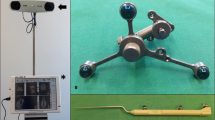Abstract
Purpose
Accurate craniotomy placement is essential for frameless neuronavigation in minimally invasive neurosurgery. A craniotomy using virtual reality (VR) can be as accurate as neuronavigation.
Methods
We prospectively enrolled 48 patients that underwent minimally invasive cranial procedures planned using VR, followed by neuronavigation. First, craniotomies were planned using VR derived measurements. Second, frameless neuronavigation was applied to define the craniotomy. The locations of these paired craniotomies were compared. A correctly placed craniotomy was defined as one that enabled the surgeon to totally remove the pathology without need to enlarge the craniotomy intraoperatively.
Results
Using VR, the size and the position of the craniotomy were measured correctly in 47 of 48 cases (98%). In 44 of 48 cases (92%), neuronavigation identified the craniotomy site correctly. In cases where neuronavigation failed, minimally invasive surgery was successfully completed using preoperative VR surgery planning. No statistically significant difference was found between craniotomy localization using VR surgery planning or standard frameless neuronavigation (p = 0.36).
Conclusion
The craniotomy for minimally invasive neurosurgical procedures can be identified accurately using VR surgery planning or neuronavigation. In cases of neuronavigation failure, VR surgery planning serves as an effective backup system to perform a minimally invasive operation.
Similar content being viewed by others
References
Barnett GH, McKenzie RL, Ramos L, Palmer J (1993) Nonvolumetric stereotaxy-assisted craniotomy. Results in 50 consecutive cases. Stereotact Funct Neurosurg 61: 80–95
Fischer G, Stadie A, Schwandt E, Gawehn J, Boor S, Marx J, Oertel J (2009) Minimally invasive superficial temporal artery to middle cerebral artery bypass through a minicraniotomy: benefit of three-dimensional virtual reality planning using magnetic resonance angiography. Neurosurg Focus 26: E20
Grunert P, Charalampaki K, Kassem M, Boecher-Schwarz H, Filippi R, Grunert P Jr (2003) Frame-based and frameless stereotaxy in the localization of cavernous angiomas. Neurosurg Rev 26: 53–61
Grunert P, Darabi K, Espinosa J, Filippi R (2003) Computer-aided navigation in neurosurgery. Neurosurg Rev 26: 73–99 (discussion 100–101)
Gumprecht HK, Widenka DC, Lumenta CB (1999) BrainLab VectorVision Neuronavigation System: technology and clinical experiences in 131 cases. Neurosurgery 44: 97–104 (discussion 104–105)
Kockro RA, Serra L, Tseng-Tsai Y, Chan C, Yih-Yian S, Gim-Guan C, Lee E, Hoe LY, Hern N, Nowinski WL (2000) Planning and simulation of neurosurgery in a virtual reality environment. Neurosurgery 46: 118–135 (discussion 117–135)
Kockro RA, Tsai YT, Ng I, Hwang P, Zhu C, Agusanto K, Hong LX, Serra L (2009) Dex-ray: augmented reality neurosurgical navigation with a handheld video probe. Neurosurgery 65: 795–807 (discussion 798–807)
McInerney J, Roberts DW (2000) Frameless stereotaxy of the brain. Mt Sinai J Med 67: 300–310
Ng I, Hwang PY, Kumar D, Lee CK, Kockro RA, Sitoh YY (2009) Surgical planning for microsurgical excision of cerebral arterio-venous malformations using virtual reality technology. Acta Neurochir (Wien) 151: 453–463 (discussion 463)
Perneczky A, Mueller-Forell W, van Lindert E, Fries G (1999) Keyhole concept in neurosurgery with endoscope-assisted microsurgery and case-studies. Thieme Verlag Stuttgart, New York
Perneczky A, Reisch R (2008) Keyhole approaches in neurosurgery volume 1: concept and surgical technique. Springer Verlag Wien, New York
Spetzger U, Hubbe U, Struffert T, Reinges MH, Krings T, Krombach GA, Zentner J, Gilsbach JM, Stiehl HS (2002) Error analysis in cranial neuronavigation. Minim Invasive Neurosurg 45: 6–10
Spivak CJ, Pirouzmand F (2005) Comparison of the reliability of brain lesion localization when using traditional and stereotactic image-guided techniques: a prospective study. J Neurosurg 103: 424–427
Stadie AT, Kockro RA, Reisch R, Tropine A, Boor S, Stoeter P, Perneczky A (2008) Virtual reality system for planning minimally invasive neurosurgery. J Neurosurg 108: 382–394
Stadie AT, Kockro RA, Reisch R, Tropine A, Boor S, Stoeter P, Perneczky A (2008) Virtual reality system for planning minimally invasive neurosurgery. Technical note. J Neurosurg 108: 382–394
Stadie AT, Reisch R, Kockro RA, Fischer G, Schwandt E, Boor S, Stoeter P (2009) Minimally invasive cerebral cavernoma surgery using keyhole approaches—solutions for technique-related limitations. Minim Invasive Neurosurg 52: 9–16
Wagner W, Gaab MR, Schroeder HW, Tschiltschke W (2000) Cranial neuronavigation in neurosurgery: assessment of usefulness in relation to type and site of pathology in 284 patients. Minim Invasive Neurosurg 43: 124–131
Wong GK, Zhu CX, Ahuja AT, Poon WS (2007) Craniotomy and clipping of intracranial aneurysm in a stereoscopic virtual reality environment. Neurosurgery 61: 564–568 (discussion 568–569)
Author information
Authors and Affiliations
Corresponding author
Rights and permissions
About this article
Cite this article
Stadie, A.T., Kockro, R.A., Serra, L. et al. Neurosurgical craniotomy localization using a virtual reality planning system versus intraoperative image–guided navigation. Int J CARS 6, 565–572 (2011). https://doi.org/10.1007/s11548-010-0529-1
Received:
Accepted:
Published:
Issue Date:
DOI: https://doi.org/10.1007/s11548-010-0529-1




